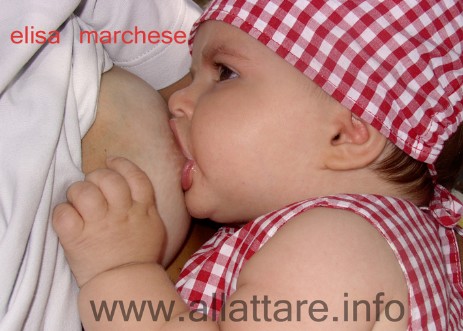Breast attachment
How to latch the baby to the breast
The best position is the one that is most comfortable for the mother.
In the classic position, the mother is seated, supports the baby with one arm along the back and the head is located near the fold of the mother's arm. The newborn's body faces the mother and is aligned (ear, shoulder, hip).
It is the newborn that must be brought close to the breast and not vice versa.
Breast attachment is commonly a spontaneous event, if necessary, touch the nipple on the baby's lips to make him open his mouth, do not exert pressure, do not push the baby's head.
If it is necessary to make the nipple protrude more (eg in the case of large breasts), exert a small pressure on the breast with the thumb above the areola and forefinger under the areola; to free the baby's nose just a little pressure on the top.
After the arrival of the milk, at the end of the feeding, keep the baby in an upright position to facilitate the "burp" (it is not said that it always does), small regurgitations are normal.
The infant is properly attached when:
- its mouth is wide open and the lower lip is curved outward
- the areola above the upper lip is more visible than the lower lip (the galactophore ducts are squeezed by the movement of the tongue)
- the infant's chin touches the breast
- there are slow and deep suctions, the mouth presses on the lactiferous sinuses located behind the nipple: this pressure occurs
- only if the baby is properly latched on
- the baby can be heard swallowing and there are no pops, signs of empty sucking
- the mother does not feel any pain (however, the first attacks, even if correct, may be slightly uncomfortable)

When to breastfeed the newborn baby
It is desirable to breastfeed the newborn baby immediately after birth, as it can improve the initial mother-child relationship; if it is not possible to breastfeed the baby, it does not affect the outcome of breastfeeding.
The first feeding should take place at a time that is calm for both mother and newborn baby, with the presence of the father and qualified personnel who will inform on the correct attachment. It is advisable, in the hospital, to keep the newborn baby with you (rooming-in) in order to favour breastfeeding on demand, and to attach the baby to the breast at the first signals .... without crying (a late sign of hunger). Even at home, there is no need to impose a timetable; the newborn baby will latch on to the breast on demand and, generally, after the arrival of the milk flow, will require feeding every 3-4 hours.
In the first few days, it is normal that there are small problems connected to breastfeeding or during the phase of the breastfeeding.
Every newborn eats and sleeps at a different pace, frequency and duration of feedings are variable, the greatest amount of milk is taken during the first minutes.
It may be a relief to precede breast-feeding by applying warm water compresses to facilitate the ejection of milk. It is advisable to attach the baby to both breasts, favouring the fuller breast initially.
Interrupt the infant's feeding
insert a finger between the tongue of the baby and the nipple and then remove it 

Hygiene and breast care
It is not necessary to clean the nipple before each feeding because the milk contains natural antiseptics that disinfect the mammary areola, after the feeding clean the breast only with water and dry well.
Bras must be loose and must be removed if they create an obstacle during breast-feeding.
Frequent use of soaps can make the skin dry and prone to cracking.
Absorbent cups (preferably made of cotton) are useful when the milk comes out in abundance from the nipple. Leaving the nipple wet can facilitate the appearance of rhagades with possible infection.
Each newborn, when placed on its mother's abdomen immediately after birth,
is able to find the mother's breast on its own and decide when to take its first feed.
This phenomenon is known as the 'Breast Crawl'.


